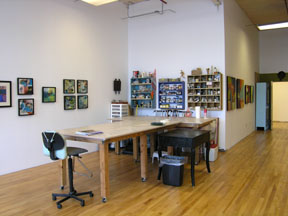 Subliminal, encaustic, rubber, tacks, patinated copper, oilstick, mixed media, 20" x 16".
Subliminal, encaustic, rubber, tacks, patinated copper, oilstick, mixed media, 20" x 16". More Subliminal, encaustic, rubber, tacks, patinated copper, oilstick, mixed media, 20" x 16".
More Subliminal, encaustic, rubber, tacks, patinated copper, oilstick, mixed media, 20" x 16".The second piece has a more shallow center section because the embedded objects are smaller (beads - thanks to Binnie Birstein's donation).
Both pieces are covered with rubber on the sides, the same way I have treated most of the work in this series.
 You can also see that the rubber protrudes and forms a channel for the encaustic section in the center.
You can also see that the rubber protrudes and forms a channel for the encaustic section in the center.
As far as the title(s) go, I had been considering calling these pieces "Underfoot", but I think "Subliminal" is more to the point. I didn't want to refer to the literal landscape although this work (especially the first piece) looks like rocks or pebbles. "Subliminal" means:
"existing or operating below the threshold of consciousness; being or employing stimuli insufficiently intense to produce a discrete sensation but often being or designed to be intense enough to influence the mental processes or the behavior of the individual: a subliminal stimulus; subliminal advertising."
(according to dictionary.com). So you could understand this work to refer to those things that we don't really observe but just feel the effects of. I guess this would be comparable to those things in the physical landscape that we take for granted and don't look at closely, such as rocks or pebbles underfoot.
I have made a conscious effort in the rubber+encaustic series to give the work a vertical orientation, meaning that they refer to the body (versus a horizontal orientation referring to the landscape). My focus is on the body these days as I am paying closer attention to the way it breaks down and changes with age. Such changes are usually subliminal until one day we wake up and realize that old age is upon us. But at least we're waking up.

 "Twins", a work I made in the mid 1990s, of mixed and found media, about 13"H x 20"W.
"Twins", a work I made in the mid 1990s, of mixed and found media, about 13"H x 20"W.






 "Tale of Shadows" diptych, top panel 9" x 12", bottom 12" x 12", book pages, encaustic, oilstick, rubber tacks.
"Tale of Shadows" diptych, top panel 9" x 12", bottom 12" x 12", book pages, encaustic, oilstick, rubber tacks.








